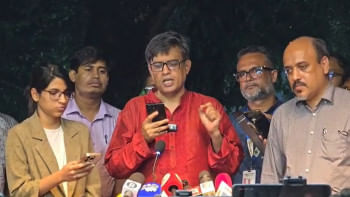Urbanisation wild in Bangladesh
The ongoing urbanisation in Bangladesh is a wild development activity, said a US-based architecture educator during an interview with this paper yesterday.
“No one is choreographing it, as policymakers lack a clear vision,” said Kazi Khaleed Ashraf on the eve of a three-day international conference on architecture fashioned “Engage Dhaka 2015” beginning today at the army museum in the capital's Bijoy Sarani.
The consequence of destruction of conservable wetlands and croplands by private real estate developers in the name of urban development all around Dhaka city's fringes will be devastating for the ecological, environmental and hydrological systems, he said.
Planned urbanisation is living collectively and equitably in a civil manner, not earth filling an area and building mere structures, Ashraf said.
“City is a dynamic space for a collective living in a decent way,” he said, “It is a highly dynamic cultural artifact, not a mere mechanical entity.”
In fact, it is all about urbanism -- a social and cultural bonding in city life with economic vibrancy. Urbanism is an ensemble of buildings, spaces and other physical facilities in a city, he said.
Walking is given the highest priority in urban mobility across the world but pedestrians in Bangladesh are not only denied footpaths but also discounted, added Ashraf.
Small car owners are given priority reducing pedestrian passages to make way for wider roads in Bangladesh while Bangkok, Tokyo, Mumbai, Kuala Lumpur, New York, Paris and London are all pedestrian cities, he said.
A city is not civilised without pedestrian passages, said Ashraf, who has been writing for around two decades on how Dhaka could be better designed in the way of urbanisation.
Mass transportation like Mass Rapid Transit is a must for Dhaka but it will not work without a functional pedestrian system, he said.
It is a civic right of a city dweller to have pedestrian passage, parks, playgrounds, plazas and festivals apart from basic services including safe water, electricity, education and healthcare, Ashraf said.
Destroying such social spaces is severely hampering social, emotional and cultural growth particularly of children, he said.
Dhaka is no more what it architecturally used to be three decades back, he said, it has experienced constant rebuilding and transformation implying a tremendous change in the city's physical and social baric, said Ashraf.
But in the context of Bangladesh, urbanisation has acquired a negative connotation of traffic congestion, lack of basic services, overpopulation, pollution and health crisis, he added.
Dhaka like any other is tremendously an emerging Asian city because of economy, incentives, entrepreneurship and migration. Dhaka's problems cannot be solved just by looking at Dhaka alone and streamlining Dhaka will not be possible without organising other cities, he said.
Architects have a responsibility to show better and viable alternatives in urban development and help prevent social inequality and deprivation, he said, and international discourse would further make the public aware of architecture.
Architects are not mere professional tools; they envision and inculcate the social and political vision. Architecture is integral to and fundamental for a planned city, said Ashraf, currently teaching architecture at the University of Hawaii in the USA and taking part in the conference along with Shamsul Wares, Bashirul Haq and Saif Ul Haque from Bangladesh.
Two among the notable books Ashraf authored include “Designing Dhaka: A Manifesto for a Better City” and “An Architect in Bangladesh: Conversations with Muzharul Islam”.
Other world famous historians, theorists, teachers and practitioners of architecture expected to take part in the conference include Fumihiko Maki from Japan, Kenneth Frampton, Farooq Ameen and Rahul Mehrotra from the USA, William JR Curtis from France, Ken Yeang from Malaysia, Han Tumertekin from Turkey, Kongjian Yu from China, Anupama Kundoo from India, Palinda Kannangara from Sri Lanka and Hector Fernandez Elorza from Spain.
Bengal Foundation is organising the conference in association with the Institute of Architects Bangladesh and is dedicating it to architect Muzharul Islam, considered the maestro pioneer of modernism in architecture in Bangladesh.

 For all latest news, follow The Daily Star's Google News channel.
For all latest news, follow The Daily Star's Google News channel. 



Comments